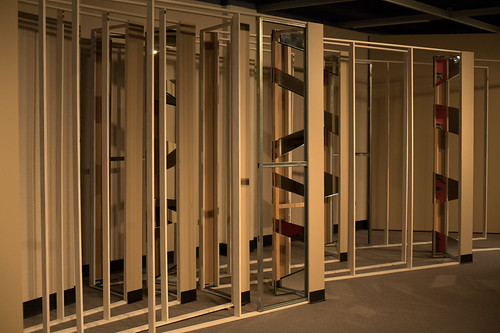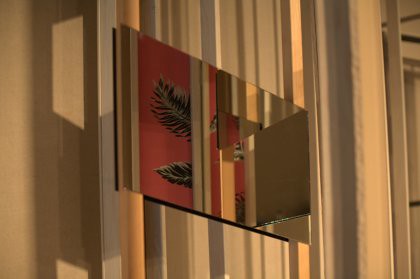‘The Framed Guests’ provokes, disorients, and satisfies lovers of conceptual art
MOILIILI—It may not look like much at a first glance—just plywood, metal studs, sheetrock, insulation, mirrors, and a smell of fresh paint. But what’s at work is an impressive structure that straddles the lines between sculpture, architecture, and installation.
The Framed Guests, currently on view at the Haigo and the University of Hawaii at Manoa’s Irene Shen Architecture Gallery (room 204 of the Architecture Building), represents a collaboration between Interisland Terminal, the UH Department of Art and Art History’s Intersections visiting artist program, and the UH School of Architecture.
The exhibition is not art for the passive viewer. Instead, the intensely conceptual work demands viewer participation in order to derive meaning.
The artist behind the work is Heather Rowe. Based in New York, Rowe has an impressive exhibition resume of high-profile appearances on the contemporary art scene, including the 2008 Whitney Biennial, PS1, the Indianapolis Museum of Art, the University of Michigan Museum of Art, and Ballroom Marfa.
During her exhibition with Interisland Terminal in Honolulu, Rowe participated in the UH’s Intersections program, working with graduate students at the UH Art Department, and giving a public lecture at the Art Department Auditorium. Rowe designed and built The Framed Guests to initiate a conversation between the practice of architecture and the lived experience of contemporary art.

Rowe uses the materials and language of architecture to both reference and reimagine a given site. The room at the Haigo and Irene Shen Architecture Gallery, in which The Framed Guests is housed, is a somewhat grim, institutional space of irregular shape, with split windows and a stained beige carpet.
The Framed Guests also marks the first time that Rowe sketched a design from plans and photographs without having any firsthand physical knowledge of the space. Once she arrived in Honolulu, she had 10 days to build it. She incorporated some found materials from the room, such as beige contact paper and vinyl molding, and tweaked some other aspects of the design once she became more intimately familiar with the site. The resulting work of art, like the space in which it resides, gives a strong impression of being unfinished—a frequent criticism of contemporary art, but in reality an invitation for the viewer to “complete” the work.
When I approached Rowe at the opening, I commented that the work seemed at once in the process of being constructed and deconstructed. She agreed with my assessment, and we discussed some of her influences—Gordon Matta-Clark, Ellsworth Kelly, Bruce Nauman, Robert Smithson, Lee Bonteque—who work with similar tensions, as well as that between the organic and the mechanic. We then went on to talk about theatricality and how her piece plays into the idea of cinematic progression.

The Framed Guests does in fact unfold in a frame by frame sequence. Step inside the labyrinth of broken planes and harsh diagonals, and a nagging sense of disorientation takes over. Walk along the “paths”—laid out as a literal series of frames—only to be rudely stopped in your tracks when they end abruptly. Look up to find an alternative route and catch a glimpse of your confused face in the jagged mirror (and believe me, the lighting is not particularly flattering). Like a dream, or a movie, when everything starts to occur in slow motion and is shot from odd, distorting angles, so is this work of art. And yet as austere as it is, there are glimmers of beauty and personality.
Fragments of a decidedly feminine wallpaper (salmony pink with plumage) create only a vague point of reference (Marie Antoinette?) but are playfully provocative and add a refreshing touch of color and whimsy to an otherwise very cerebral creation. Overall, it offers a stimulating encounter with yourself as well as your fellow viewing companions.
For more information, visit www.interislandterminal.org or www.hawaii.edu/art/intersections.